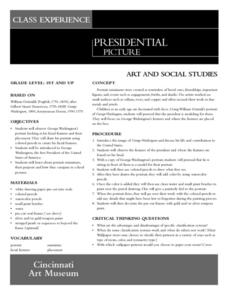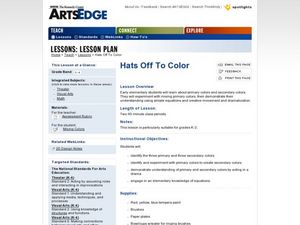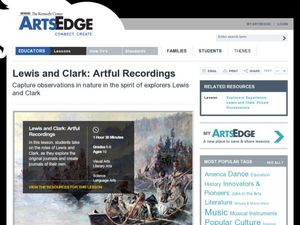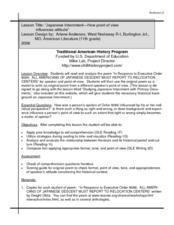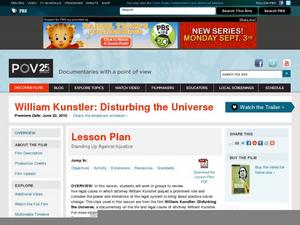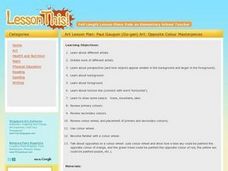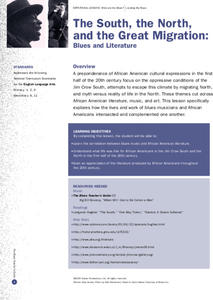Curated OER
Presidential Picture
Students create miniature portraits of George Washington using a primary source image, watercolor pencils, colored pencils and white drawing paper. This Art lesson can be used as an introductory lesson on George Washington in a U.S....
Curated OER
Hats Off to Color
Students investigate primary and secondary colors. In this art lesson, students mix primary paint colors to develop secondary colors. Students identify each color they created.
Curated OER
The Great Gatsby: Primary Sources from the Roaring Twenties
Students research the Roaring Twenties. In this 1920's America lesson, students analyze primary sources to develop an understanding of lifestyles and values of the era as they read F. Scott Fitzgerald's The Great Gatsby.
Curated OER
Spicy Hot Colors
First graders discover the importance of primary colors by reading a book in class. In this art lesson, 1st graders read the book Spicy Hot Colors, and discuss the three primary colors and the numerous combinations they can make....
Curated OER
Lewis and Clark: Artful Recordings
Students examine the nature journals of Lewis and Clark. For this primary source analysis lesson, students research the journals that the members of the Corps of Discovery kept during the expedition and then conduct further research on...
Curated OER
Nonviolence as a Tool for Change Lesson 1
Young scholars examine voting rights in the South during the 1950s and 1960s. In this civil rights lesson, students examine legal rights and the opportunity to cast votes. Young scholars research primary documents regarding the topic and...
Canadian War Museum
Comparing Primary and Secondary Sources
This simple two-day lesson plan introduces learners to the differences between primary and secondary sources. The lesson plan includes group work that explores the similarities and differences, and the advantages and disadvantages of...
Curated OER
"Sentences - Can You Make Them?"
Here is a great lesson on how to make a complete sentence. Young writers "drag and drop" the words using the mouse. This is a fantastic activity to use with "Word Wall Words." It provides practice in making sentences, as well as...
Curated OER
Japanese Internment--How Point of View Influences Attitude
How does background and experience influence one's point of view? Dwight Okita's famous poem about the Japanese internment is the text used to explore this essential question. Class members study primary documents to gain the necessary...
PBS
Standing Up Against Injustice
“Sometimes things are lawful yet are actually wrong.” Researchers examine primary and secondary source materials as they study five legal cases involving civil rights attorney William Kunstler in which he attempted to use the legal...
Alabama Department of Archives and History
Strange Fruit: Lynching in America
To continue their study of the Civil War, Reconstruction, and the beginning of the civil rights movement, class members watch the YouTube video of Billie Holiday singing "Strange Fruit" as an introduction to an examination of lynching in...
Curated OER
Character Attributes in Writing
Third graders analyze the importance of characters in fiction writing and performances. In this theatre instructional activity, 3rd graders identify the important characteristics of a fictional character and how to portray a character...
Curated OER
Why Do We Remember Revere? Paul Revere's Ride in History and Literature
Students examine primary documents regarding Paul Revere's ride and its role in the Revolutionary War. They consider how Revere's role has been written about by Longfellow and others and discuss the discrepancies between accounts.
Curated OER
Paul Gauguin Art: Opposite Colour Masterpieces
Students discover new art techniques by examining the work of Paul Gauguin and his use of opposite colors. In this art analysis instructional activity, students investigate the different perspectives and colors used in classic post...
Curated OER
About Life: The Photographs of Dorothea Lange Going to the Promised Land
To better understand the migrant experience during the Great Depression, pupils analyze two primary resources: photographs by Dorothea Lange and a U.S. Map that shows the Dust Bowl. They compare and contrast Lange's images to Steinbeck's...
National Woman's History Museum
How Do We Remember and Honor the Contributions of Women in Public Space?
Public art, especially monuments and memorials, are designed to celebrate and honor those who have made significant contributions to a community or even an entire nation. Here's a lesson that asks scholars to consider who is represented...
Curated OER
Henry VII - How Did Henry VII Get Up In the Morning?
Examine the daily life of Henry VII. In this Henry VII lesson, learners answer questions about the life in Medieval times after looking at primary source documents which are translated into contemporary English.
Captioned Media
Creating Dramatic Monologues from The Grapes of Wrath
Set in Oklahoma in the 1930s, The Grapes of Wrath presents a powerful view of life during the Great Depression. An insightful lesson plan takes a closer look at the characters in John Steinbeck's classic novel, combining the descriptions...
Curated OER
Past, Present and Future Through the Eyes of Long Jakes
Even the littlest learners can become art historians if they have the right training. For the lesson, your preschoolers discuss the piece Long Jakes as they point out all the details they notice. They discuss what mountains and mountain...
Curated OER
Introduction to Age of Absolutism
Who were the absolute monarchs of Europe and what effect did they have on their countries? Young historians begin by naming qualities they believe are important for a monarch to possess. They then take notes on four key factors leading...
Curated OER
The Finer Things in Life
Momoyama and Edo are periods in Japanese history that can be defined culturally and artistically. Learners explore and discuss how the samurai used sword guards and grip enhancers. Pupils read the story "The Inch-High Samurai," examine...
Curated OER
The South, the North and the Great Migration: Blues and Literature
Here is a complex lesson plan that interweaves the history of the Jim Crow South and the Great Migration with the study of poetry, art, and blues music from the Harlem Renaissance. The plan helps young historians develop a deep...
Curated OER
Street Cows
A light, and humorous lesson on "street cows" is here for you. Learners listen to the story, "Street Cows," which is embedded in the plan. On a map of the US and the World, they locate the cities where the "Cows on Parade" exhibit was...
Curated OER
Season Tiles: Ceramics Lesson
Each color holds its own feeling and these feelings are used to describe the four seasons. Youngsters create a color palate based on the four seasons, assigning various colors to each season. They each create four clay tiles, painting...
Other popular searches
- Art Lessons Primary Penguins
- Edible Art Lessons Primary
- Art Lessons Primary Easter
- 3d Art Lessons Primary
- Art Lessons Primary Fruit
- Winter Art Lessons Primary
- Maori Art Lessons Primary
- Visual Art Lessons Primary
- Art Lessons Primary Tiger
- Art Lessons Primary Water
- Art Lessons Primary Victoria
- Art Lessons Primary Art


